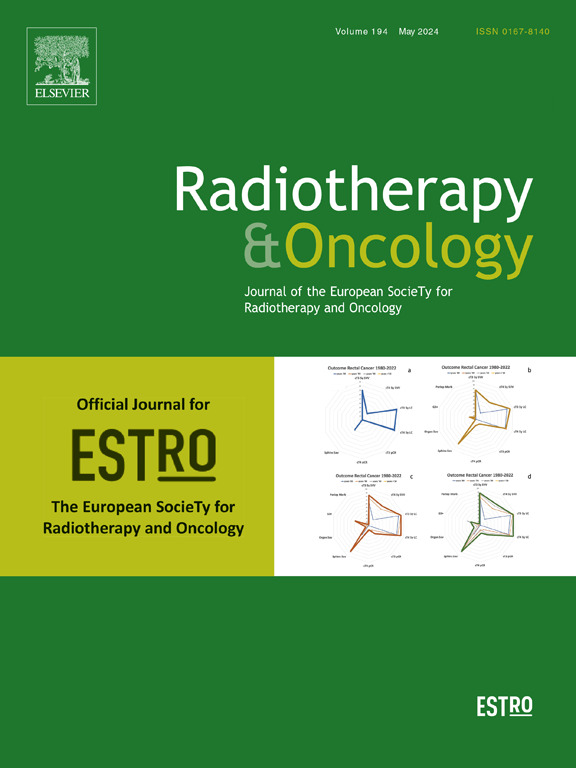Electron vs proton FLASH radiation on murine skin toxicity
IF 4.9
1区 医学
Q1 ONCOLOGY
引用次数: 0
Abstract
Background and purpose
Dose-response modification of FLASH has previously been established for acute skin toxicity in protons. This study used a similar experimental setup to quantify the dose–response modification of electron FLASH irradiation for acute skin- and late fibrotic toxicity in mice. The setup similarity enabled quantitative comparison of the acute skin response for electrons to protons.
Method
Female unanaesthetised C3D2F1 mice were restrained with the right hindleg fixated and submerged in a water bath for horizontal electron irradiation at 16 MeV. Mice were randomised in groups of varying single doses (19.4–57.6 Gy) and irradiated with either 0.162 Gy/s conventional (CONV) or 233 Gy/s FLASH dose rate using 8–10 mice per group. Acute skin toxicity was assessed daily from the 8th to the 28th day post-irradiation. The same mice were kept for a fibrotic assay of leg extension assessment done biweekly until 52 weeks post-irradiation. The dose-modifying factor (DMF) of FLASH was quantified from dose-response curves.
Results and discussion
Electron FLASH irradiated mice showed a considerable skin-sparing effect with a DMF of 1.45–1.54 and a smaller fibrotic-sparing effect with a DMF of 1.15. The development of acute skin toxicity was similar between CONV and FLASH groups with biological equivalent doses based on the DMF. The acute response of the electron irradiations was similar to previous reports on protons.
Conclusion
Despite apparent differences, e.g. average and instantaneous dose rates, the acute skin toxicity of electron beams and previously published proton beams were remarkably similar regarding both biological response and quantified acute skin DMFs.

背景和目的:先前已经建立了FLASH对质子急性皮肤毒性的剂量-反应修饰。本研究采用类似的实验设置,量化电子闪光照射对小鼠急性皮肤和晚期纤维化毒性的剂量反应修饰。设置的相似性使电子对质子的急性皮肤反应的定量比较成为可能。方法:将未麻醉的雌性C3D2F1小鼠右后腿固定,置于水浴中进行16 MeV水平电子照射。小鼠被随机分为不同单剂量组(19.4-57.6 Gy),并以0.162 Gy/s常规(CONV)或233 Gy/s FLASH剂量率照射,每组8-10只小鼠。照射后第8 ~ 28天,每天进行急性皮肤毒性评价。同样的小鼠每两周进行一次腿部伸展评估的纤维化试验,直到照射后52 周。根据剂量-反应曲线定量测定FLASH的剂量修饰因子(DMF)。结果和讨论:电子闪光照射小鼠显示出相当大的皮肤保留作用,DMF为1.45-1.54,而较小的纤维保留作用,DMF为1.15。基于DMF的生物等效剂量,CONV组和FLASH组之间急性皮肤毒性的发展相似。电子辐照的急性反应与先前关于质子的报道相似。结论:尽管平均剂量率和瞬时剂量率存在明显差异,但电子束和先前发表的质子束的急性皮肤毒性在生物反应和量化急性皮肤DMFs方面都非常相似。
本文章由计算机程序翻译,如有差异,请以英文原文为准。
求助全文
约1分钟内获得全文
求助全文
来源期刊

Radiotherapy and Oncology
医学-核医学
CiteScore
10.30
自引率
10.50%
发文量
2445
审稿时长
45 days
期刊介绍:
Radiotherapy and Oncology publishes papers describing original research as well as review articles. It covers areas of interest relating to radiation oncology. This includes: clinical radiotherapy, combined modality treatment, translational studies, epidemiological outcomes, imaging, dosimetry, and radiation therapy planning, experimental work in radiobiology, chemobiology, hyperthermia and tumour biology, as well as data science in radiation oncology and physics aspects relevant to oncology.Papers on more general aspects of interest to the radiation oncologist including chemotherapy, surgery and immunology are also published.
 求助内容:
求助内容: 应助结果提醒方式:
应助结果提醒方式:


